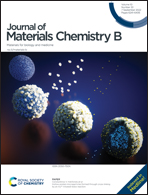Halogen-bridged binuclear iridium(iii) complexes with enhanced photodynamic therapeutic effects in mitochondria†
Abstract
The development of high-performance photosensitizers is the top priority in photodynamic therapy (PDT). Iridium complexes are widely used because of their many advantages such as high photostability, long T1 lifetime, high yield of singlet oxygen generation, and so on. Halogen-bridged binuclear complexes are often used as intermediates in the synthesis of photosensitizers but ignored in PDT applications. Here we found that halogen-bridged binuclear iridium complexes showed excellent performance in 1O2 generation. It was also confirmed that these complexes kill tumor cells by inducing apoptosis. Through molecular design and modification, we studied the effect of the bridging halogen atoms and intracellular localization on the performance of PDT. The results show that replacing the bridging halogen with heavier atoms and targeting the complex in mitochondria can effectively enhance the efficiency of PDT. Among them, the bromine bridged binuclear iridium complex located in mitochondria reported in this paper can achieve an IC50 value of 75 nM for MCF-7 cells. This work also provides inspiration for the exploration of complex-based photosensitizers.



 Please wait while we load your content...
Please wait while we load your content...